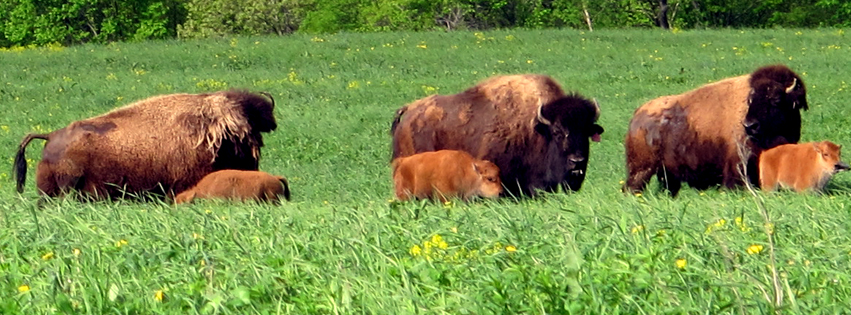I am an advocate for using customized native seed mixes for habitat restoration. While designing a unique mix takes time, it can be well worth the extra effort. The right mix of plants can boost the long-term ecology and function of a landscape and can be particularly important for working lands – those with multiple uses like agroforestry, grazing and silvopasture.
Research indicates that careful grazing, especially with bison, can increase insect species richness and diversity. Marrying invertebrate conservation with sustainable farming practices always feels like a win, and it is really fun to take part in the initiation of those systems with a high-quality seed mix.
Restoration with multiple goals calls for creative solutions
Last year, I had the privilege of working on a seed mix puzzle that stretched my imagination and forced me to balance lofty ecological goals with specific cost and program constraints. Thanks to a grant from the Wildlife Conservation Society (WCS), Xerces was able to bring some funds to a 20-acre habitat planting at Rockie Hill Bison Farm in Winona, MN. The owners, Gail and Dave Griffin, were participating in the Conservation Reserve Program (CRP) and had been contracted to plant a native mix for wildlife purposes. CRP pays farmers to take land out of production for a set number of years, usually 10- or 15-year terms. In order to receive federal financial assistance for the project, they needed a mix that would conform to specific CRP requirements.
Gail expressed interest in turning the native planting into a bison pasture at the end of their CRP contract, so in addition to designing something that would meet the federal program standards, we also wanted to plan for potential large herbivore forage palatability down the road. Xerces’ objectives included providing key nectar and pollen resources for imperiled pollinators like the rusty patched bumble bee and monarch butterflies, while also maximizing biodiversity and climate adaptability of the habitat.
This photo from Rockie Hill Bison Farm depicts a portion of the project acreage along the treeline (black charred area). Gabe Ericksen and his crew burned the unit prior to planting the custom seed mix in May 2021. Photo credit: Gabe Erickson.
Balancing the needs of grazing bison and pollinators
We worked through many iterations of the mix in collaboration with an exceptionally thoughtful restoration practitioner in the area, Gabe Ericksen. Together, we compiled a list of species to include (or not) in the mix:
- Plants to avoid due to their potential toxicity for bison, including some Buttercup family species like Delphinium and Ranunculus;
- Plants that are known to have high palatability and nutrition, like native legumes;
- Plants that have lower palatability but are valuable to pollinators, such as members of the mint family like Monarda and Pycnanthemum; and
- Plants that are critically important to support imperiled pollinators. This included milkweeds for monarch butterflies and an abundance of blooms throughout the growing season to support bumble bees.
After deciding on our species list, we had to set overall seeding rate goals (approximately 50 seeds per square foot total) and grass to wildflower ratios. We decided to aim for approximately 60% grasses/sedges and 40% wildflowers, assuming the grass component would be important for bison health, weight gain, and nutrition. We also wanted to ensure a diverse native plant community - whether without bison (the first 10 years of establishment), or with bison, who shape their habitat in myriad ways through grazing, trail building, wallowing, and developing nutrient patches.

This photo was provided by Gail Griffin, co-owner of Rockie Hill Bison Farm. For her, this image with three cows and calves “resonated to positive futures. During these challenging times, we are in need of hope. The calves will create the future of the species, and their offspring will enjoy our work in restoration.” Photo: Gail Griffin
After developing our ideal mix, we had to trim everything up to get our dreams to fit into a reasonable budget. We landed on a mix that included: 57 total native species (44 wildflowers and 13 grasses/sedges); a ratio of 64% grasses and 36% wildflowers based on seeds/square foot; a seeding density of 48 total seeds/square foot; 2 milkweed species; 24 monarch-preferred nectar plants, and 18 plant species that are preferred by the endangered rusty patched bumble bee. All this for less than $400/acre. No doubt, we could have done more if budget were not an issue, but when is that ever not the case? Given the real-world constraints we were operating under, I think all of us felt confident that we optimized the mix for the multitude of aspirations we brought to the project.
The mix was planted in May of 2021; now we wait to see if it will bring into fruition our collective vision. An inspiring local ecologist and grazing advocate, Stephen Thomforde, weighed in saying that the mix was a beautiful madness: “I can hear in this mix the mouths of bison munching, and wings of pollinators buzzing, and the sound of meadowlarks singing, the sound of happy living native pastures, as they have been for thousands of years.”




